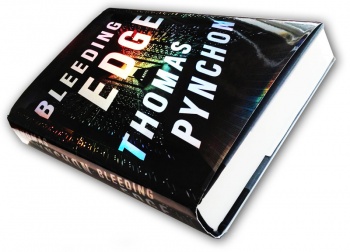Difference between revisions of "Bleeding Edge cover analysis"
| Line 8: | Line 8: | ||
Also, with its receding vanishing point perspective, the front and back cover image brings to mind the dust jacket design on the first American edition of [http://v.pynchonwiki.com/wiki/index.php?title=V. ''V.''] (1963). | Also, with its receding vanishing point perspective, the front and back cover image brings to mind the dust jacket design on the first American edition of [http://v.pynchonwiki.com/wiki/index.php?title=V. ''V.''] (1963). | ||
| − | Furthermore, the cover image seems to resonate with this famous passage from the closing pages of ''The Crying of Lot 49'', where | + | Furthermore, the cover image seems to resonate with this famous passage from the closing pages of ''The Crying of Lot 49'', where Pynchon's first female sleuth, Oedipa Maas, imagines herself inside a great computer: |
"For it was now like walking among matrices of a great digital computer, the zeroes and ones twinned above, hanging like balanced mobiles right and left ahead, thick, maybe endless" (p. 181) | "For it was now like walking among matrices of a great digital computer, the zeroes and ones twinned above, hanging like balanced mobiles right and left ahead, thick, maybe endless" (p. 181) | ||
Revision as of 04:36, 18 September 2013
The dust jacket for the first hardback edition, although technically in grayscale, has a shiny finish that reflects light in shifting colors depending on the angle from which it's viewed. There's likely a name for this effect, but I don't know it!
The image of the server farm, which is on both the front and back covers, evokes two of the main themes in Bleeding Edge — the Internet and the World Trade Center twin towers.
Also, with its receding vanishing point perspective, the front and back cover image brings to mind the dust jacket design on the first American edition of V. (1963).
Furthermore, the cover image seems to resonate with this famous passage from the closing pages of The Crying of Lot 49, where Pynchon's first female sleuth, Oedipa Maas, imagines herself inside a great computer:
"For it was now like walking among matrices of a great digital computer, the zeroes and ones twinned above, hanging like balanced mobiles right and left ahead, thick, maybe endless" (p. 181)

